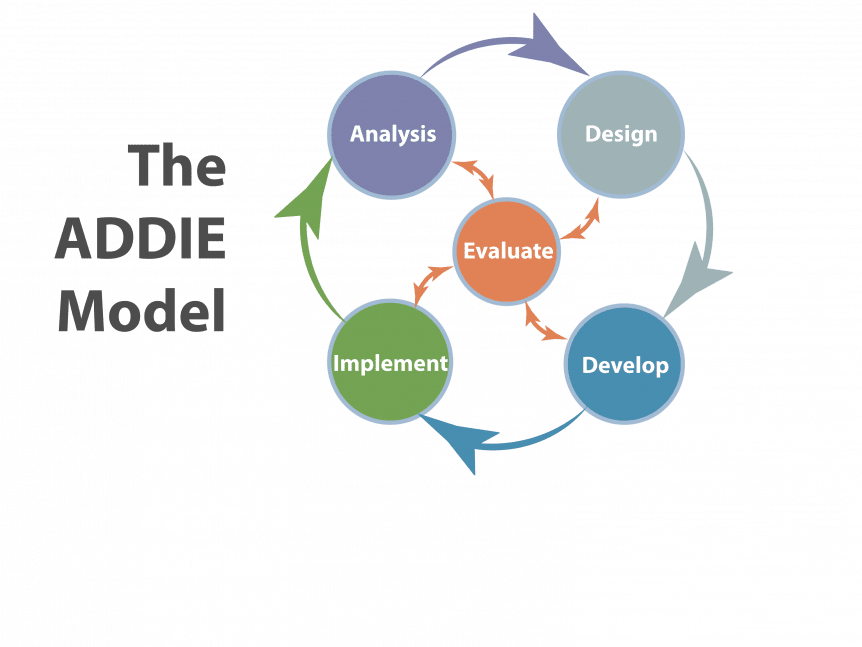Instructional design is an important part of the e-learning development process, but it is a concept rather than a descriptive approach. This means there is no single way to implement instructional design. Instead, there are models that e-learning developers use to ensure they adhere to instructional design principles. ADDIE is one of the most common instructional design models.
What is ADDIE, how does it work, what are the limitations, and what are the benefits? We’ll explain all in this blog. But first, let’s recap quickly on instructional design.
What is Instructional Design?
Instructional design is about creating learning experiences that enable learners to acquire and use new skills and knowledge. It doesn’t happen by accident, however, and it can’t be achieved through good intentions alone.
Instead, there needs to be a considered approach to the development of e-learning courses to ensure instructional design principles are achieved. One of the ways to do that is through the ADDIE instructional design model.
An Introduction to ADDIE
ADDIE is an acronym:
· Analyse
· Design
· Development
· Implementation
· Evaluation
The acronym describes a five-stage e-learning development process. It has been around for decades now, and, despite its detractors, it still has relevance today. Let’s look at each of the five steps.
Analyse
· Define your learning objectives.
· Identify skills gaps and then define what learners know now and what you want them to know after they have completed the course.
· Understand your learners, including who they are, their learning motivations, their current level of knowledge or skills, and their attitudes to training and development.
· Consider the expectations of your learners – what tone or style of e-learning course will they expect, and what will produce the most positive response?
· Align the course and your learning objectives with the wider business strategy.
· Decide on the learning outcomes you want to achieve and how those outcomes will be measured.
Part of this step in the ADDIE model could also involve assessing your capabilities and technical skills. What elements of the development can you complete in-house, what has to be completed in-house, and what should be outsourced?
Design
· Identify and engage subject matter experts.
· Develop a structure and user flow for the e-learning course.
· Determine the training strategies that will be used, i.e., microlearning, just-in-time learning, blended learning, etc.
· Determine if there is a localisation and translation requirement for the course and how that will be implemented.
· Create wireframes, storyboards, and prototypes of the e-learning course.
· Assess existing materials to determine if they can be re-purposed. Complete any re-purposing work that is required.
· Create any new materials that are required.
· Develop the various media elements that will be required, i.e., images, video, infographics, etc.
Develop
· Develop the e-learning course, including writing any code and creating the various elements such as scenarios, quizzes, gamified elements, etc.
· This step involves bringing everything produced in the previous step together to create the actual e-learning course.
· Testing and quality assurance are also important elements of this step in the ADDIE process.
Implementation
· Create a strategy for implementing the e-learning course, including communicating with learners.
· Identifying champions is often important, as is getting support from key leaders. This could be anything from direct line managers to the C-suite, depending on the topic of the course.
· Identify barriers that could exist and develop mitigation plans. An example is someone who doesn’t have the technical ability to complete the course. How can you overcome this barrier?
· In some situations, it is beneficial to implement the e-learning course with a test group of learners to identify potential problems and identify areas that can be improved.
· Begin rolling out the course to learners.
Evaluate
Evaluate the success of the course through various methods:
· Results from quizzes
· Follow-up tests in the weeks and months after the course has been completed
· Observations of behavioural change
· Changes or improvements in objective metrics, such as customer satisfaction metrics or sales figures
· Learner feedback
Views and opinions are important but measuring results against the original objectives and desired learning outcomes is also essential.
From your evaluation of the e-learning course and its impact, identify areas that can be improved either in the existing course or for future projects.
Is ADDIE Still Relevant?
The relevance of ADDIE in the modern world of agile development is often discussed. The theory is that the clearly defined five-step process is at odds with an agile approach. However, the reality is that most e-learning developers still use ADDIE (or a form of it) as a framework.
Firstly, the five steps don’t have to be completed in isolation, as there can and usually is quite a bit of overlap. In other words, the ADDIE model shouldn’t be a linear process.
Also, the ADDIE model creates a crystal-clear flow for developers that is applicable in any situation. For example, whatever approach you take to e-learning development, it doesn’t make sense to start developing content or wireframes before you have defined your objectives and got an understanding of your learners. ADDIE provides this development flow and structure.
Providing a Structure to Instructional Design
In modern e-learning development projects, the five steps that make up the ADDIE model are not standalone, where each is completed in sequence. Instead, they provide a framework to ensure the development project delivers on the requirements of learners and the organisation’s learning objectives.
